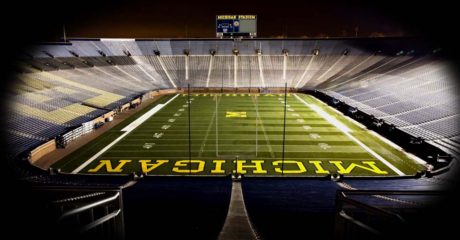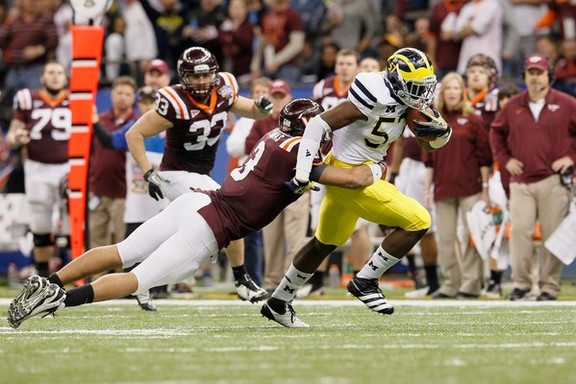2012 Spring Game Review – Defense
 |
| Senior WILL Brandin Hawthorne was Saturday’s defensive MVP |
DEFENSIVE ENDS
I thought Craig Roh looked pretty darn good at strongside end. The starter at weakside end was Brennen Beyer, who looks significantly bigger this spring than he did in the fall. He looked like a bona fide weakside end instead of a lanky outside linebacker. Beyer got a good pass rush a couple times. Meanwhile, backup weakside end Frank Clark performed solidly and made a nice hit on fullback Joey Kerridge, whom Clark chased down out of the backfield. I also thought backup strongside end Keith Heitzman looked pretty solid. Based on how Nathan Brink looked last year, I’m going to posit that Heitzman passes up Brink this fall. (Brink sat out the spring game, still recovering from his broken leg.)
DEFENSIVE TACKLES
William Campbell looked alternately solid and inconsequential. He had one or two good plays but he just didn’t seem to be going hard all the time. He should have destroyed walk-on guard Joey Burzynski (or so I would think) but instead got stalemated too often. Maybe the coaches are teaching him differently than I would expect, but it all seemed to start with his stance, which needs work from my perspective. Jibreel Black looks like a matchup nightmare for a lot of offensive guards, because he’s too quick to handle with any consistency. He looks bigger than last year (although the neck roll might have had something to do with that). It also seems that Richard Ash has taken a step forward, and I was surprised by how big backup 3-tech Chris Rock has become. I saw glimmers of hope there for some competent rotation players. Quinton Washington and Ken Wilkins still didn’t impress me.
LINEBACKERS
I didn’t pay much attention to Jake Ryan because we already know he’s a good player. Kenny Demens looked solid but unspectacular at MIKE. Desmond Morgan left the scrimmage early after getting chopped down on a blitz; he limped to the sideline and was later carted into the tunnel. Hopefully it was nothing serious. Cam Gordon was Ryan’s backup at SAM, and he’s definitely put on some weight since last year. Now he looks like a linebacker rather than a strong safety. I don’t think he’ll surpass Ryan, but he’s a very good backup. It will be interesting to see what the coaches do with him in 2013 as a senior, because by that time, I don’t think they’ll be able to afford to keep him off the field. Mike Jones and Joe Bolden played as backup middle linebackers, but neither one was particularly visible. I saw a couple loafs out of Antonio Poole, which does not bode well for his immediate future. Kaleb Ringer looked like he was in great shape and he made a nice tackle on Justice Hayes, but both of those guys seem to be a ways down on the depth chart. The linebacker who impressed me most on the day was Brandin Hawthorne, who made a couple nice tackles for loss and grabbed a one-handed pick, albeit off walk-on Jack Kennedy, who floated the ball across the middle. Hawthorne looked good at times last year, too, but he’s another guy who loafs once in a while, and that seemed to get him in the dighouse. The linebackers now have depth, which we haven’t been able to say for several years. I truly believe that Michigan has five starter-level linebackers: Ryan, Gordon, Demens, Morgan, and Hawthorne.
CORNERBACKS
J.T. Floyd started over Terrence Talbott, despite reports that Talbott had overtaken Floyd. That was somewhat expected. Floyd looked solid but was never tested deep. Blake Countess made a nice pick on a late Devin Gardner throw and also made a couple nice tackles. The backup cornerbacks did not impress me, although I don’t remember seeing much out of Talbott. Maybe he’s the third guy and we’ll be fine, but I don’t think Raymon Taylor and Delonte Hollowell are ready. We know Courtney Avery is pretty solid at the nickel corner, and although he pulled up on a tackle, it seemed like he was trying not to submarine the leaping receiver; if it were a game, I would be disappointed by that play, but I think he was just trying not to hurt his teammate.
SAFETIES
The starting safeties weren’t really tested in the running or the passing game. Jordan Kovacs should be good and practice reports suggest that Thomas Gordon has improved once again, but I guess we’ll have to wait and see on him. Backup free safety Jarrod Wilson needs to get stronger. He did miss a tackle on Thomas Rawls that turned into a touchdown, but Wilson should be struggling through senioritis and ordering his prom tux right now. Tackling 220 lb. running backs is a tough task for a safety so young. Marvin Robinson looked solid as the backup strong safety and made a nice tackle for little or no gain in the run game. As long as Robinson’s legal troubles are behind him, I expect him to improve and be a good in-the-box safety. He should be a good replacement for Kovacs after the latter graduates.




